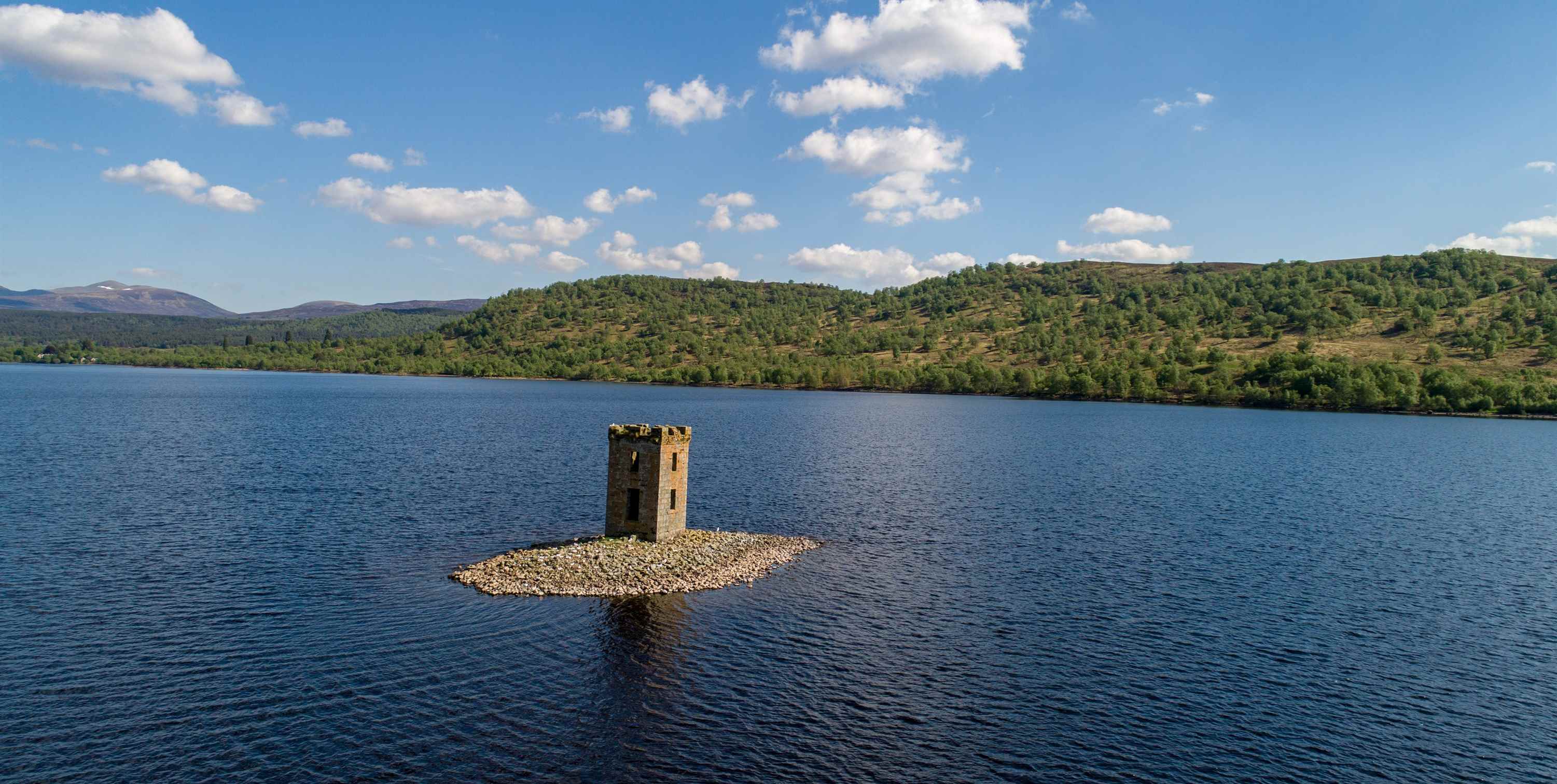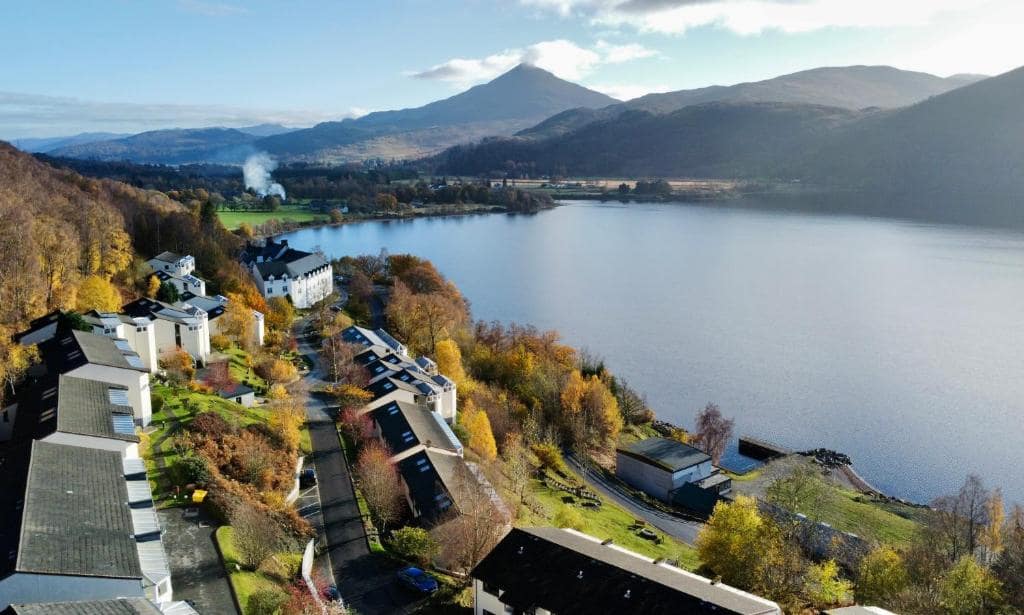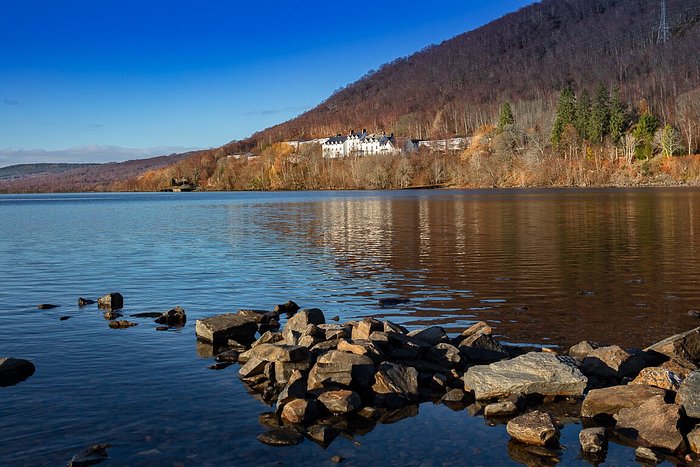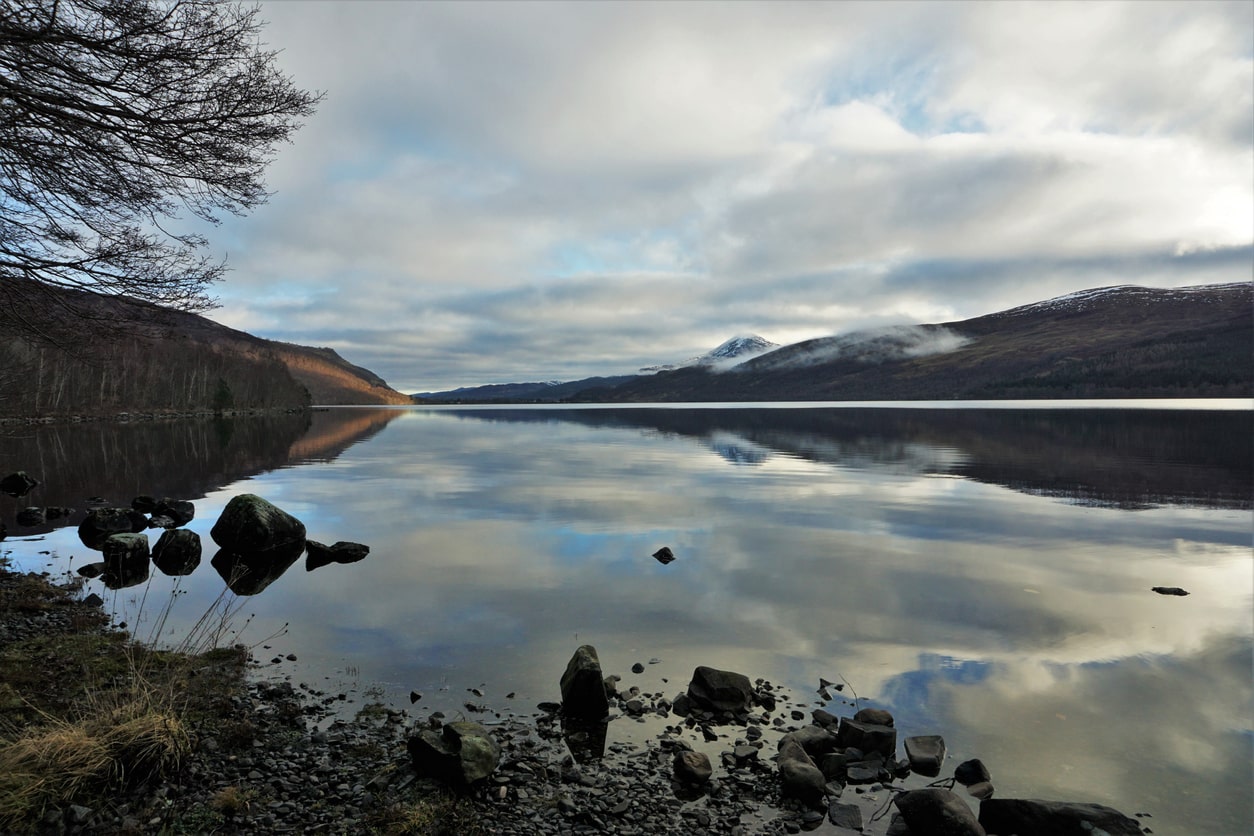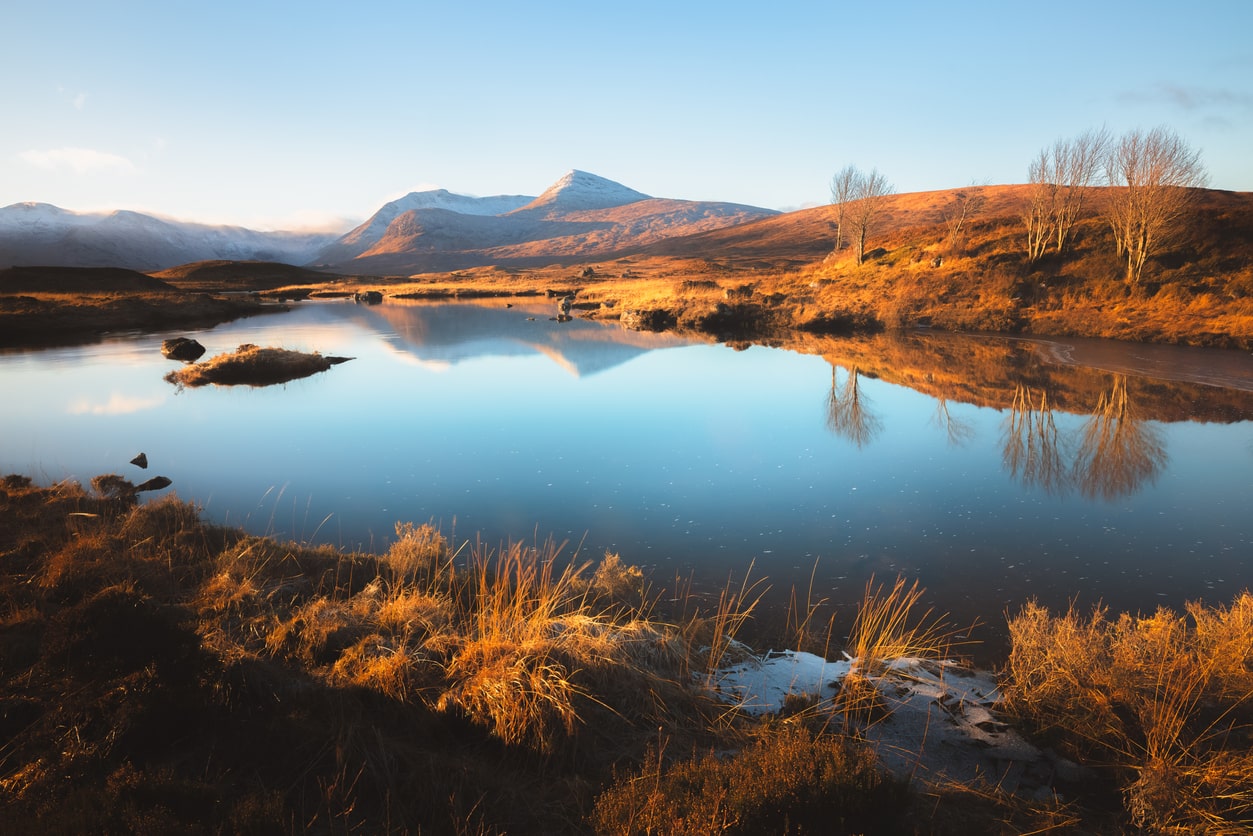Loch Rannoch is a freshwater loch situated in Highland Perthshire, Scotland. Often described as one of Scotland's most beautiful bodies of water due to its tranquil setting, it stretches over 9 miles in length and is around 1 mile wide at most points. The loch was carved out by glaciers during the last Ice Age which ended roughly 11,700 years ago, leaving behind a long, narrow trench as the ice retreated. Nowadays, Loch Rannoch is surrounded by the heather moorlands and Caledonian pine woods of Rannoch Moor and the heather-clad hills and mountains of the Central Highlands. These rugged surroundings contrast with the generally smooth and mirror-like surface of the loch itself.
The River Tummel begins at the eastern end of Loch Rannoch at a point known as The Meeting of the Waters, where Tummel and Ericht converge. The Tummel then winds its way for 46 miles through spectacular Highland scenery before reaching the town of Pitlochry and ultimately flowing into the River Tay. Loch Rannoch therefore forms part of the vast Tay catchment area - one of the largest and most important river networks in the whole of Scotland.
The Legends and Lore of Loch Rannoch
As with many bodies of water in remote Scottish locations, Loch Rannoch has inspired a rich tradition of myths and legends over the years. These tales handed down through generations give insight into how the local landscape, wildlife and even weather conditions have captured imaginations and come to be explained by colourful stories. One enduring legend tells of a fierce battle between opposing clans on the shores of Loch Rannoch one tempestuous winter's night many centuries ago. As swords clashed furiously, the ground suddenly gave way on the loch's southern bank, plunging the warriors into the dark icy waters below. Their enraged spirits now haunt that spot on wild wintry nights, appearing as ghostly lights floating eerily over the loch. Locals named this place Caisteal nan Con, meaning "Castle of the Dogs" in Gaelic.
Other folklore speaks of a mystical crannog that contains hidden treasure dating back to the Iron Age. Loch dwellers fleeing marauders were thought to have hastily buried their prized weapons and jewels for safekeeping just before their fortress was ransacked and burnt. Centuries later, only on Midsummer's Eve when conditions are deemed right, it's told that a shimmering walkway appears leading out over the water to the magical hoard... but none have yet claimed it! With such enduring legends combining fact and fantasy over generations, it's clear the unique environment around Loch Rannoch will continue to spark imaginative stories as more people explore the area and revel in its mystique. Always remember - not everything has a rational explanation here! Let your imagination fill in the rest.
Geography and Settlements
In terms of human geography, Loch Rannoch is something of a secluded spot, far away as it is from any major towns or trunk roads. The tiny settlement of Kinloch Rannoch lies at the eastern end of the loch and provides a small service centre for visitors and tourists. The scenic villages of Tummel Bridge and Rannoch Station are located nearby at key road junctions.
Loch Rannoch is situated in Highland Perthshire in central Scotland. It lies around 60 miles to the west of Perth and a similar distance to the north of Glasgow and Edinburgh. The loch stretches for over 9 miles from east to west while reaching 1 mile in width at most points. It covers an area of around 8 square miles. The loch occupies a trench gouged out by glaciers with the surrounding terrain rising sharply from its banks. The area surrounding Loch Rannoch forms one of the most remote and unpopulated parts of mainland Britain. Kinloch Rannoch on the eastern banks is the only sizeable village with permanent residents numbering in the low hundreds. Other tiny settlements include Bridge of Gaur, Innerhaddon and Georgetown dotted along the northern shoreline. The southern banks are uninhabited except for the isolated Loch Rannoch Highland Club.
Roads provide access to both ends of Loch Rannoch at Kinloch Rannoch and Rannoch Station. The south side has no thoroughfare meaning several miles of dead-end minor roads terminate at isolated spots on the banks. Otherwise, the West Highland Railway Line passes along the loch's north shore whilst hiking trails crisscross the area for walkers. The nearest significant towns are Pitlochry and Aberfeldy around 15 miles to the east. These serve as tourist centres providing amenities for visitors. To the west across desolate Rannoch Moor lies Glencoe, itself over 50 miles distant. So locals and tourists depend on Kinloch Rannoch to meet basic needs. The overriding impressions of the locale are therefore of an expansive natural wilderness with just a few pockets of human habitation bringing vital resources. The landscape itself takes centre stage here.
Landscape and Activities
Nowadays Loch Rannoch guards less against conflict and persecution but certainly still preserves a sense of retreat from modern life. Its inherent peace and beauty fosters relaxation; its forests offer sanctuary for wildlife; its clean waters facilitate natural habitats and ecosystems; and its mountains and glens simply inspire. The loch itself forms the central feature around which tudo-grass meadows, Caledonian pine forests, rocky bluffs and heather moorland gather to create a classic Highland scene. The loch reflects the surrounding greenery and hills like a mirror whilst clouds drift lazily overhead as wildlife grazes calmly on its banks.
Beinn a' Chreachain
The peak of Beinn a’ Chreachain rises dramatically to over 3,000 feet, looming steeply over the southern shores of Loch Rannoch. Known as “Hill of the Foresters” in Gaelic, its slopes display heather and blaeberry giving way to craggy outcrops closer to the summit. Several walking routes wend their way upwards including one of the Great Trail national walking paths, rewarding ramblers with panoramic views across the wilderness of Rannoch Moor. Look out too for herds of red deer grazing on the lower hillsides. For the adventurous, cautious scrambling permits access to the pinnacle where magnificent vistas open up over the length of Loch Rannoch. Seeking this airy viewpoint above Loch Rannoch makes for a memorable day’s hike but come well prepared for changeable conditions on the higher ground.
Woodland Trails
Remnant fragments of the ancient Caledonian Forest still cloak pockets of land around Loch Rannoch. Hiking woodland trails through this mossy, lichen-festooned habitat gives tantalising glimpses into Scotland’s mist-shrouded past when much of the Highlands were blanketed in the mighty Scots Pine. Follow winding paths linking secluded meadow clearings carpeted in foxgloves, bluebells and lush grass. Gaze skywards through dense needles to admire the soaring trunks and branches silhouetted against bright patches of blue. Lose yourself in a living relic of our primaeval forests, home to rare wildlife undisturbed for generations. But tread lightly here and leave no trace - this precious remnant ecosystem remains under threat and requires careful conservation to preserve its timeless magic.
Fishing and Boating
The cold clean waters of Loch Rannoch provide ideal conditions for salmon spawning streams and habitats for lively wild brown trout which grow large fighting their way upstream from the loch into feeder burns and rivers. Hardy anglers cast flies and lure from drifting boats or the banks as clouds scud across brooding mountain peaks reflected in the loch's mirrored surface. The loch also supports populations of schelly, eels, sticklebacks, minnows and Arctic char. As well as anglers, kayakers, canoeists and wild swimmers also appreciate tranquil views below the surface whilst sculling across still bays or exploring steep wooded shores. Whether sitting quietly with rod in hand waiting for a bite or propelling yourself through crystalline waters, be sure to pause now and then to soak up the romantic isolation of this timeless loch which so captivated legendary author Robert Louis Stevenson during his epic voyage through Scotland’s waterways.
Cycling and Running
Quiet single-track roads circle the loch, mostly level and winding through forests and moors with very light traffic. These idyllic lanes lend themselves perfectly to relaxed bike rides or ambling walks whilst the occasionally undulating terrain also provides a sufficient challenge for cyclists if desired. Route 7 of the National Cycle Network traces the northern shore and connects to adjacent paths beyond the loch for longer adventures. Road cyclists and racers also frequent the loop which forms part of several sportives. Meanwhile, hardy athletes take on the marathon and ultra-marathon running challenges around the loch, perhaps aiming to go full circle or out-and-back along its 9-mile length, tracing the footpath or winding back roads. And failing that, there’s always “prodding” - the quirky Scottish sport of sprinting between consecutive laybys the entire perimeter of Loch Rannoch which crowns the victor with the accolade of “Loch Prodder Champion”! Whatever your pace, enjoying the simplicity of life and propelling yourself under your own steam around this jewel amongst lochs brings great rewards.
Accommodation and Places to Stay
Accommodation provision in the vicinity of Loch Rannoch caters well for most tastes and budgets. This spans small bed & breakfast establishments to country house hotels; self-catering cottages to boutique hideaways; backpacker bothies to campsites with panoramic vistas.
Luxury Country House Hotels
For visitors seeking a luxurious place to stay and dine in spectacular scenery, country house hotels around Loch Rannoch provide pampering hospitality, fine dining and country pursuits in historic buildings with log fires, four-poster beds and refined furnishings. Dating back over 150 years, the Loch Rannoch Highland Club, the Macdonald Loch Rannoch Hotel and the Rannoch Station Hotel all offer this level of elite accommodation. Guests can unwind by the fire in antique-filled drawing rooms, feast on locally sourced produce, and partake in fishing, shooting, archery, tennis on private courts and more. These handsome estates evoke a bygone era of Highland grandeur combined with modern expectations of comfort. Waking up to mist-wreathed peaks reflected in calm waters outside your window epitomises the timeless romance of the Scottish Highlands.
Modest Smaller Hotels & Inns
Not as grand yet still very comfortable and full of character, smaller hotels and old coaching inns give a delightful taste of traditional Highland hospitality. Typically dating from the 19th century, expect hearty Scottish fare such as venison and haggis alongside real ales and whiskies in atmospheric public bars where perhaps local musicians gather beside the glowing fireplace of an evening. Surrounded by history reminiscent of Robert Louis Stevenson’s novels, these welcoming places to stay include the Bridge of Gaur Guest House, the Loch Tummel Inn and the Struan Inn.
Self-Catering Cottages
Scattered across the loch shores are characterful stone cottages available to rent on a self-catering basis, often on working farm estates dating back centuries. These provide flexibility for families and groups seeking a remote location to base themselves in while exploring the region. Some were built over 150 years ago by crofters yet now offer modern amenities alongside original flagstone floors and open fireplaces. Guests can live out rural fantasies in these tranquil settings by collecting eggs, bottle-feeding lambs or visiting farm shops. Most cottages come with private fishing rights while some have rowing boats included for summer fun with no other properties in sight.
Camping & Hostels
For those simply seeking fresh air, access to nature and a place to pitch their tent or park a campervan, campsites surround Loch Rannoch starting from around £7 per night. These range from almost wild lochside grassy swards with open vistas to small managed sites tucked behind pine forests with facilities such as power hookups. There are also bunkhouses, bothies and backpacker hostels costing very little. Wake up to mist rolling across the loch and the cry of oystercatchers from your inexpensive waterside pitch before stoking up the camping stove to prepare a hearty breakfast as the early morning sun burns away the haar.
Secluded Lodges & Glamping
In addition to conventional accommodation, there are increasing options for unusual and creative places to stay catering to tourists looking for something a bit different. Secluded timber lodges tucked into birch forests come with private hot tubs overlooking the loch. Luxurious yurts and tipis with wood-burning stoves offer back-to-nature comforts. These modern takes on traditional themes open up Loch Rannoch to glamping opportunities - quite literally glamorous camping ideal for groups seeking a remote and scenic location away from crowds. Wood-fired outdoor hot tubs provide front-row views for unforgettable sunsets behind distant peaks before retiring to comfortable beds in warm canvas tents illuminated by lanterns.
Related Articles

Let us know you agree to cookies
We use marketing, analytical and functional cookies as well as similar technologies to give you the best experience. Third parties, including social media platforms, often place tracking cookies on our site to show you personalised adverts outside of our website.
We store your cookie preferences for two years and you can edit your preferences via ‘manage cookies’ or through the cookie policy at the bottom of every page. For more information, please see our cookie policy.
